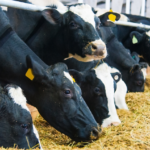
6 Things You’ve Heard about Milk that are Wrong
There are a lot of misconceptions out there about milk. We’ve outlined six of the most prevalent that you might be hearing.
1. Drinking organic milk means you won’t be ingesting growth hormones.
You may have heard that drinking organic milk keeps you from ingesting growth hormones, while drinking the non-organic counterpart means you are exposing yourself to growth hormones. The truth is no matter what type of animal milk you drink – conventional or organic – you are ingesting growth hormones, because growth hormones are naturally present in all milk and it comes from a living animal.
According to Dr. Ann Macrina, Research/Teaching Associate at Penn State University, “All milk naturally contains various hormones, including growth hormone. Cows naturally produce this hormone, also known as somatotropin or bST, and it can be found in milk in small quantities.”
Learn more about growth hormones and hormones in milk.
2. Drinking conventional milk means you are supporting the overuse of antibiotics.
So, you’ve heard that by drinking conventional milk you are supporting the overuse of antibiotics. The truth is that in the dairy industry antibiotics are used to treat sick animals.
Dr. Ann Macrina says, “Cows that have illnesses such as respiratory infections, uterine infections after calving, or mastitis are candidates for antibiotic treatment. The American Association of Bovine Practitioners, a veterinary group dedicated to care of cattle, recommends antibiotic treatment only when necessary. The only time cows receive antibiotics to prevent mastitis is at the beginning of the dry period. This is when we stop milking the cow approximately 60 days before she is due to calve and start her next lactation. Treatment at this time is effective in preventing new infections, which could then require even greater use of antibiotics.” The Canadian Association of Bovine Vets also agrees with this statement.
What about residue from antibiotics in milk? According to Dr. Stuart Price, Auburn University, “Food animals treated with antibiotics must undergo a withdrawal period before products from them (such as meat or milk) can be processed for food, to allow time for the drug to be cleared from the tissue and thus prevent residues from being consumed.”
Learn more about antibiotics in food production.
3. Drinking conventional milk endangers the health of cows.
Many conventional dairy cows eat genetically modified (GM) grain and you may have read that GM grain is less healthy for cows than a non-GM grain diet.
According to Dr. Ann Macrina, “There is no evidence that genetically modified grain is unhealthy for dairy cows. GM grain used to feed dairy cows does not have a different nutrient composition compared to non-GM grains. Today’s dairy cows have high levels of milk production, requiring a high nutrient intake. Forages alone cannot meet this need, so grains are added to increase the nutrient density of the diet. However, feeding too much grain can have a negative impact on health, so dairy cattle diets are formulated to have an appropriate balance of both forages and grains.”
Also, you may be surprised to hear there are no nutritional difference between GM plants and non-GM plants when considering food for humans or animals. According to Dr. Peggy Lemaux, Cooperative Extension Specialist at the University of California-Berkeley, “Foods that have been genetically modified undergo testing for safety, health and nutrient value. The nutritional value of GM foods is tested and compared against non-GM foods. Numerous studies have shown no nutritional differences between commercially available GM and non-GM foods. In fact, genetic modification can actually improve the nutritional content of some foods, for example low linoleic acid canola oil can reduce trans-fat content. In these cases, the foods must be labeled to show the nutritional differences according to FDA policy.”
Learn more about GM and non-GM foods.
4. Drinking conventional milk is harming the environment.
You may have heard that drinking conventional milk is harmful to the environment because many conventional dairy cows are fed GM grain and GM crops are bad for the environment. We reached out to expert Dr. Martina Newell-McGloughlin, Department of Plant Pathology at the University of California-Davis, to learn more about how GM crops impact the environment.
Dr. Newell-Mcgloughlin said, “An economists’ study analyzing GM crops a couple years ago determined that pesticides’ footprint is down by about 35 percent for corn and 25 percent for cotton. In addition, there is a reduction in carbon dioxide emissions of 286 million kilograms. This is because herbicide-tolerant seeds (which create herbicide-tolerant plants) allow farmers to practice no-till agriculture – that is, they don’t have to plow the land (which causes carbon dioxide to be released). This also means the soil integrity is retained so the organic matter is much healthier, there is less soil compaction because you’re not driving over the land, and water usage is better because it is being retained in the soil. As well, because you’re not driving over the land, fuel usage is lower. In fact, fuel usage is estimated to be about 20 gallons less per acre.”
Learn more about the impact of GMOs on the environment.
5. Drinking milk means you are consuming herbicide and pesticide residue.
As a result of GM grain being fed to conventional dairy cows, you may have heard that drinking conventional milk means you are consuming herbicide and pesticide residue. As stated previously, Dr. Martina Newell-McGloughlin says “an economists’ study analyzing GMO crops a couple years ago determined that pesticides’ footprint is down.”
Furthermore, Dr. Carl Winter, Director, FoodSafe Program, Extension Food Toxicologist, says, “The present risks posed from pesticide residues in the diet are considered by most health professionals to be negligible and further reduction in pesticide residue exposure through increased consumption of organic foods is unlikely to result in any additional health benefit for consumers.”
Read more about pesticide concerns.
6. Drinking conventional milk means you are getting fewer nutrients than if you drink organic milk.
Have you heard that organic milk provides more nutrients than conventional milk? Well, it turns out that this just is not true.
Dr. Ann Macrina says, “Organic milk is not more nutritious than conventional milk. The levels of fat, lactose, and total solids are similar. One study showed a slightly higher protein concentration in organic milk compared to conventional milk. This is likely due to differences in herd management on organic farms and the fact that lower-producing cows usually produce milk higher in protein content. Cows on organic farms generally produce less milk than cows on conventional operations. The difference in protein content is small and likely would not account for any differences in total protein intake by consumers.”
It’s important to know that both organic and conventional milk are equally safe and each provide 16 essential nutrients.
“Milk Cans” by Richard BHmizo is licensed under CC BY 2.0.






























